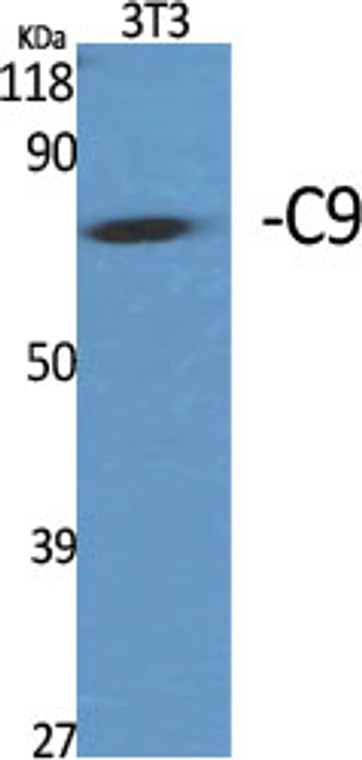| Host: |
Rabbit |
| Applications: |
WB/ELISA |
| Reactivity: |
Human/Rat/Mouse |
| Note: |
STRICTLY FOR FURTHER SCIENTIFIC RESEARCH USE ONLY (RUO). MUST NOT TO BE USED IN DIAGNOSTIC OR THERAPEUTIC APPLICATIONS. |
| Short Description: |
Rabbit polyclonal antibody anti-Complement component C9 (181-230 aa) is suitable for use in Western Blot and ELISA research applications. |
| Clonality: |
Polyclonal |
| Conjugation: |
Unconjugated |
| Isotype: |
IgG |
| Formulation: |
Liquid in PBS containing 50% Glycerol, 0.5% BSA and 0.02% Sodium Azide. |
| Purification: |
The antibody was affinity-purified from rabbit antiserum by affinity-chromatography using epitope-specific immunogen. |
| Concentration: |
1 mg/mL |
| Dilution Range: |
WB 1:500-1:2000ELISA 1:40000 |
| Storage Instruction: |
Store at-20°C for up to 1 year from the date of receipt, and avoid repeat freeze-thaw cycles. |
| Gene Symbol: |
C9 |
| Gene ID: |
735 |
| Uniprot ID: |
CO9_HUMAN |
| Immunogen Region: |
181-230 aa |
| Specificity: |
C9 Polyclonal Antibody detects endogenous levels of C9 protein. |
| Immunogen: |
The antiserum was produced against synthesized peptide derived from the human C9 at the amino acid range 181-230 |
| Post Translational Modifications | Thrombin cleaves factor C9 to produce C9a and C9b. Phosphorylation sites are present in the extracellular medium. Initially, positions and connectivity of disulfide bonds were based on peptide sequencing done for the human protein. The crystal structures for the human and mouse proteins corrected the positions and connectivities of the disulfide bonds. The distance between Cys-57 and Cys-94 in the monomeric mouse protein precludes formation of a disulfide bond, contrary to what is seen in the structure of the human polymeric form of the protein (Probable). |
| Function | Constituent of the membrane attack complex (MAC) that plays a key role in the innate and adaptive immune response by forming pores in the plasma membrane of target cells. C9 is the pore-forming subunit of the MAC. |
| Protein Name | Complement Component C9 Cleaved Into - Complement Component C9a - Complement Component C9b |
| Database Links | Reactome: R-HSA-166665Reactome: R-HSA-977606 |
| Cellular Localisation | SecretedTarget Cell MembraneMulti-Pass Membrane ProteinSecreted As Soluble MonomerOligomerizes At Target MembranesForming A Pre-PoreA Conformation Change Then Leads To The Formation Of A 100 Angstrom Diameter Pore |
| Alternative Antibody Names | Anti-Complement Component C9 Cleaved Into - Complement Component C9a - Complement Component C9b antibodyAnti-C9 antibody |
Information sourced from Uniprot.org
12 months for antibodies. 6 months for ELISA Kits. Please see website T&Cs for further guidance









